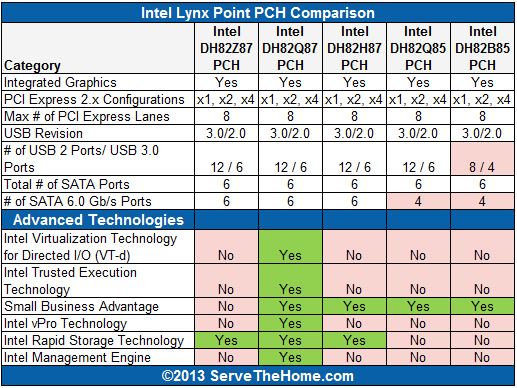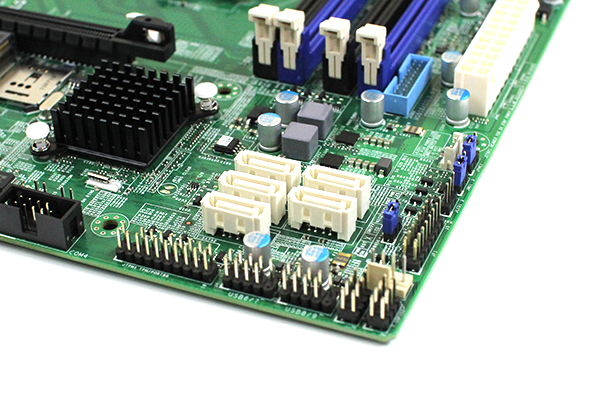The Intel Haswell series of processors launched with the new LGA1150 socket. Along with the new socket comes a new Lynx Point family of PCH options. Key differences this time around are additional USB 3.0 and SATA III ports onboard. Previous generation LGA1155 chipsets had a maximum of two SATA III 6.0gbps ports from the PCH as an example. As we have seen with the C226 chipset on the server/ workstation side, Lynx Point does have the capability to provide more connectivity. Today we are looking at five of the major launch consumer and business chipsets: Z87, Q87, Q85, H87 and B85. The goal is to compare differences since they can be a bit confusing. Over time we will likely see other PCH options find their way into retail designs such as the H81 which is expected to be popular in mini ITX designs supporting only one DIMM per channel (16GB maximum.) Let’s take a quick look at some of the key differences.
The quick answer to the difference between the Z87, Q87, Q85, H87 and B85 chip sets is that they target different users. The Intel Z87 PCH is targeted at higher-end LGA1150 workstations and gaming platforms. Users get features such as the ability to utilize Tri-SLI/ Crossfire, overclock K series parts, and generally see motherboard manufacturers trying to add rich onboard features. The H87 platform allows for up to two SLI GPUs which is adequate for the vast majority of users. If one looks at typical configurations with add-on GPUs, the single GPU configuration is the most popular. The other major feature one loses with the H87 is the ability to have
The Q87 and Q85 platforms are meant for business users. The Q87 chipset supports Intel vPro. Despite some saying it is a security leak, it is a huge help to administrators wanting to get business users up and running quickly. The Q85 PCH does not support vPro.
On the lower cost side, the B85 PCH is meant to be a budget platform. Many of the motherboards we see with the B85 chipset offer little in the way of extra features and Intel itself does not give the B85 vPro, VT-d, Rapid Storage Tech and other major features. Still the B85 is less expensive and makes a very viable platform.

For those wondering, here is a quick Intel ARK link to the five chipsets compared.
Here is an important factor to consider when looking at a chipset. Generally, onboard features cost less to add than using add-in expansion cards. If one can get a desired feature built-into the motherboard, then it will yield significant cost savings in most cases. That means that PCH selection may be biased by available motherboard options. Looking at the initial ASUS lineup we see the following chipset breakdown:
- Z87 – 15 motherboards
- H87 – 4 motherboards
- Q87 – 1 motherboard
- Q85 – 0 motehrboards
- B85 – 3 motherboards
Of course that is one vendor and focused on release motherboards, but it does show a telling trend. One can see a similar trend looking at NewEgg’s selection with 51 Z87 motherboards listed, 18 H87 motherboards listed, 17 B85 motherboards listed and 2 Q87 motherboards listed. The net result is that if one wants to find extra onboard features, the Z87 platform simply has more options.
One other major note, Intel has extended the Small Business Advantage platform to all but the Z87 PCH listed above. Last year I authored a piece at Tom’s Hardware on Small Business Advantage which should give one a good idea of what Intel is providing with their new platform.





I would have loved to know for the Z87 motherboards, the amount of DIMM slots and the maximum amount of supported memory, for homelab hypervisors.
thanks.
Erik
Z87 motherboards are dual channel designs generally with 2 DIMMs per channel which means 4 DIMMs total. Each DIMM can be up to unbuffered 8GB for a total of 32GB.
Above 32GB one should look at the LGA2011 and LGA1356 platforms.
Plus you probably want vt-d at some point which only the Q87 supports
I suppose than that table was made with the data provided from Intel Ark. However, I don’t think the VT-d info is accurate. Supermicro and AsRock claims that they do have support for VT-d on Z87 Motherboards, and Intel themselves claims VT-d support on one of their B85 Motherboards:
http://www.intel.com/support/motherboards/desktop/sb/cs-030922.htm
I would love a comparision between the Desktop Chipsets and the Server ones, namely C222, C224 and C226. I was intending to purchase a Xeon E3-1245 V3 that got the integrated GPU, however, C222 and C224 doesn’t allow you to use it. This means that the only choice if I were intending to use a Server Motherboard would be C226, and there seems to be few of those.
Otherwise, I could simply drop it on a Desktop Motherboard. But with a full feature (And accurate!) comparision between C226 and Z87 to know exactly what I’m getting/missing, the choice could be easier.